Dong Thap, the land of serene lotus fields, is not only famous for its immense rice paddies and honest people but also hides a precious gem of ecotourism – Tram Chim National Park. This place is likened to a “miniature Dong Thap Muoi,” a pristine natural painting, rich in biodiversity, and especially captivating during the floating season. Join “Du lịch khắp thế gian” to explore the wonders awaiting you at Tram Chim, a must-visit destination when you come to the Mekong Delta.
1Tram Chim National Park: Detailed Introduction to a Unique Ecotourism Destination
1.1 Prime Location and How to Get to Tram Chim National Park
Tram Chim National Park is located in Ward 4, Tram Chim town, Tam Nong district, Dong Thap province. This location places Tram Chim right in the heart of the Plain of Reeds (Dong Thap Muoi), a vast and biologically diverse wetland region of Vietnam.
To reach Tram Chim National Park, you can choose from various means of transportation:
- Bus: From Ho Chi Minh City or Can Tho, you can easily take a bus to Dong Thap. At the Dong Thap bus station, you can continue by taxi or motorbike taxi to Tram Chim town and the national park.
- Motorbike: For those who love backpacking and want to control their itinerary, a motorbike is an ideal choice. From Ho Chi Minh City, you can follow National Highway 1A, then turn into National Highway N2 or National Highway 30 to reach Dong Thap. The route is quite easy and well-signposted.
- Private car (car): If traveling with family or a group of friends, a private car will provide comfort and convenience. You can look up directions on Google Maps and drive as instructed.
Tram Chim National Park Contact Information:
- Address: Ward 4, Tram Chim town, Tam Nong district, Dong Thap province.
- Opening hours: 06:00 AM – 08:00 PM daily.
- Phone: 0277 3827 436 – 0277 8565 678
- Website: https://tramchim.net.vn/
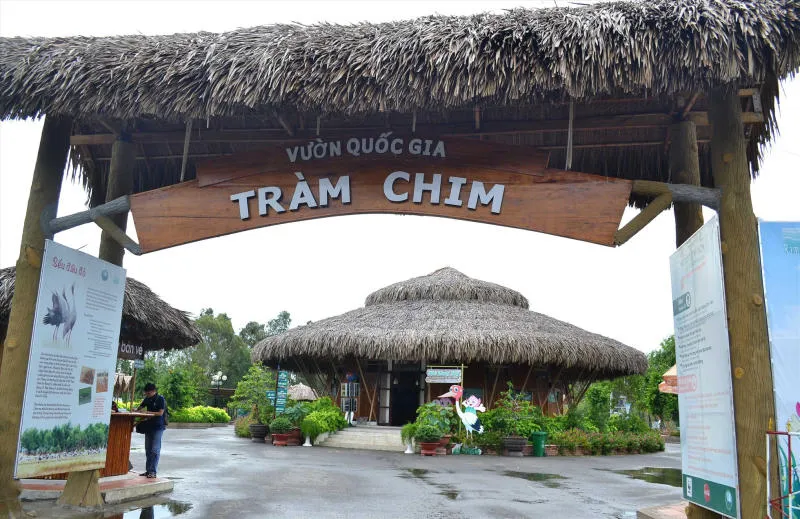
1.2 The Great Significance and Special Values of Tram Chim National Park
Tram Chim National Park is not only an attractive tourist destination but also carries great significance in nature conservation and biodiversity. Recognized as the 4th Ramsar site of Vietnam and the 2000th of the world, Tram Chim plays an important role in protecting the typical wetland ecosystem of the Plain of Reeds.
Ecological value:
- Conservation of rare and precious flora and fauna: Tram Chim National Park is home to hundreds of species of flora and fauna, including many rare species listed in the Vietnam and world Red Books, especially the Sarus crane.
- Diverse ecosystem: With a large area, Tram Chim possesses many different types of ecosystems such as cajuput forests, flooded grasslands, swamps, and rain-fed rice fields, creating a rich living environment for organisms.
- Climate and environmental regulation: The Tram Chim wetland plays an important role in regulating climate, filtering water, and mitigating the impacts of climate change.
Cultural and tourism value:
- Attractive ecotourism destination: Tram Chim attracts tourists with its pristine natural beauty, fresh air, and unique, Mekong Delta-style tourism experiences.
- Education and raising awareness: Tram Chim National Park is an important environmental education center, helping to raise community awareness about nature and biodiversity conservation.
- Local economic development: Ecotourism in Tram Chim contributes to creating jobs and income for local people, promoting sustainable economic development.
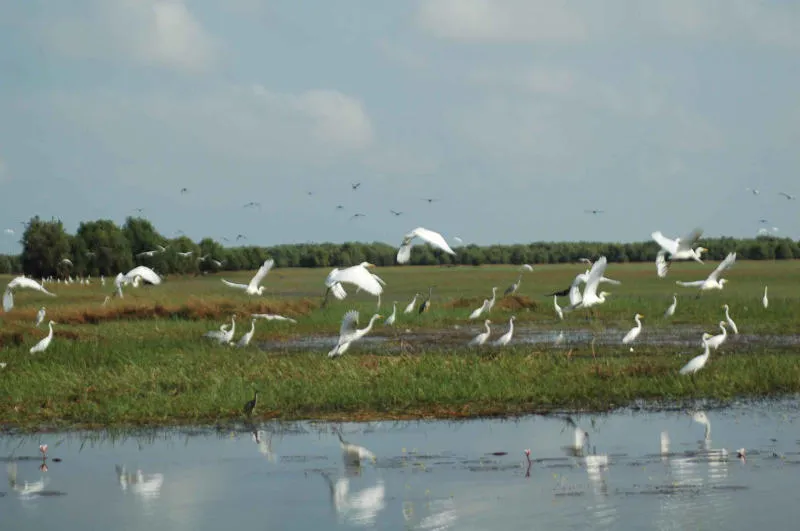
2Entrance Fees and Other Costs at Tram Chim
To fully explore the beauty of Tram Chim National Park, you need to understand the information about entrance fees and services here. The entrance fee to Tram Chim National Park is quite reasonable, suitable for many types of visitors. However, the experience services inside are more expensive, but in return, you will have unforgettable memories.
Reference ticket prices (updated July 2023):
- Entrance ticket: 20,000 VND/person.
- Composite boat rental (10 guests/boat): 500,000 VND/trip.
- Kayak and paddle boat rental: 50,000 VND/person/session.
- Boat rental to visit bird breeding grounds (once a year): 270,000 VND/person.
- Farmer training course: 200,000 VND/person.
- Overnight stay: 150,000 VND/person.
- Tour guide rental: 100,000 VND/person.
Note:
- The above ticket prices are for reference only and may change depending on the time and policies of the National Park.
- It is advisable to contact Tram Chim National Park directly to update the latest ticket price information and book services in advance, especially during peak tourist season.
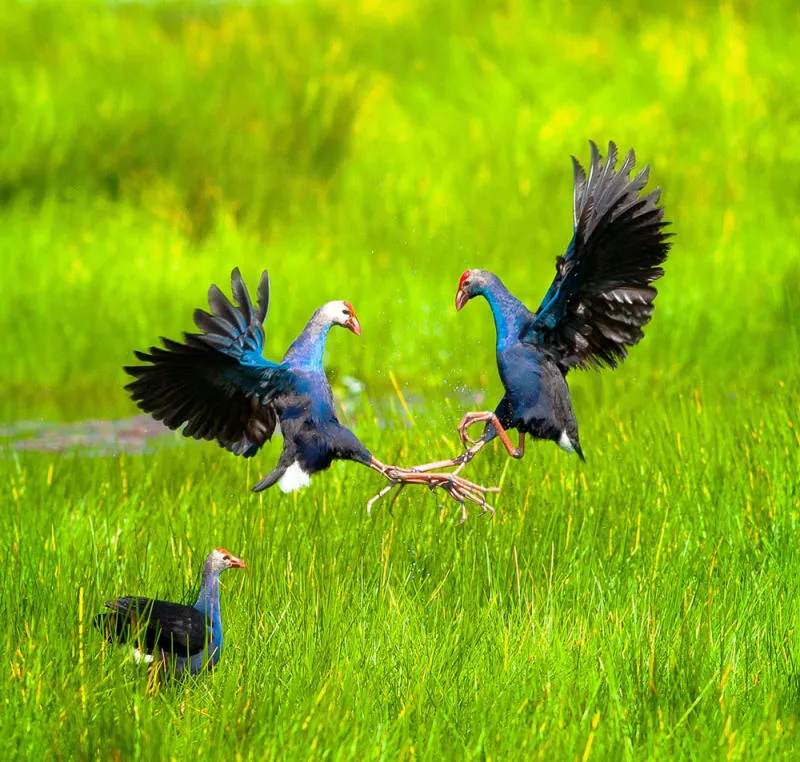
3Choosing the Best Time to Visit Tram Chim National Park
Tram Chim National Park has its own unique and charming beauty each season. Depending on your preferences and purpose of the trip, you can choose the most suitable time to explore Tram Chim:
3.1 Floating Season: Brilliant Beauty and Unique River Experiences (September – December)
The floating season from September to December is considered the golden time to visit Tram Chim National Park and the Mekong Delta in general. At this time, Tram Chim puts on a new coat with beautiful, vibrant natural scenery:
- Lotus and water lilies in full bloom: Throughout the canals and lakes in the national park are covered with pink and white lotus and water lilies, creating a beautiful watercolor painting.
- Bird breeding season: The floating season is also the breeding season for many bird species, you will have the opportunity to admire thousands of birds flying in the sky and see young bird nests on cajuput trees.
- River experiences: This is an ideal time to participate in activities such as boating, fishing, casting nets, setting traps, and experiencing the life of people in the Mekong Delta.
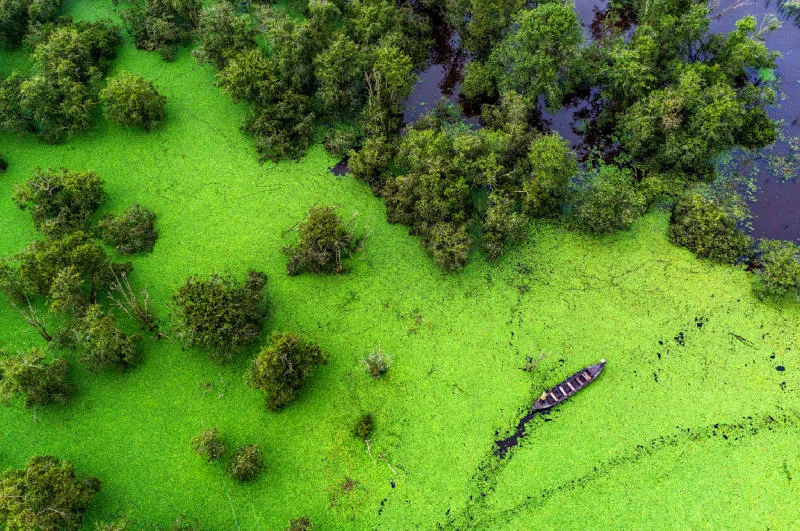
3.2 Sesbania sesban Flower Season: Brilliant Yellow Carpet Covering the Land (December – February)
From December to February of the following year, Tram Chim National Park is dyed yellow by the color of Sesbania sesban flowers. This wild flower grows in large carpets, stretching across the fields, creating an extremely impressive and romantic scene.
- Admire Sesbania sesban flowers: Coming to Tram Chim in this season, you will admire the brilliant beauty of Sesbania sesban flowers, a typical flower of the Plain of Reeds.
- Take souvenir photos: The yellow flower carpet is a great background for unique and impressive check-in photos.
- Cool weather: The weather in this season is usually cool, very suitable for outdoor sightseeing and picnic activities.
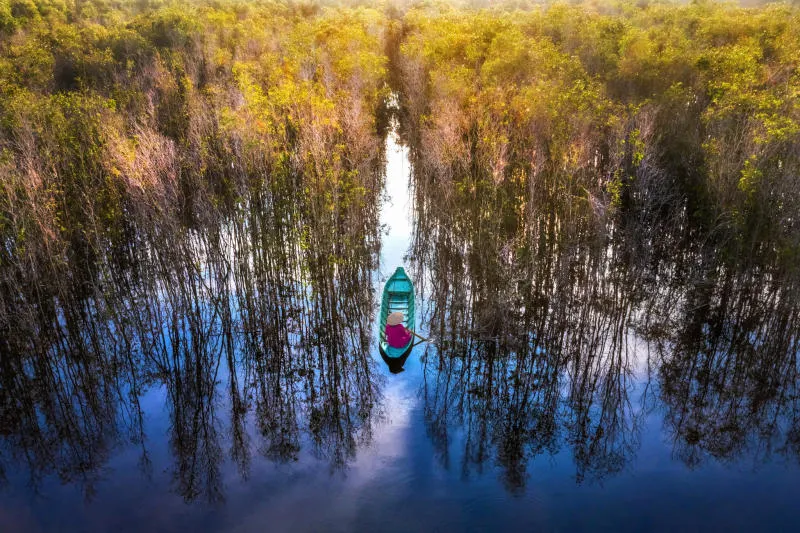
3.3 Utricularia bifida Flower Season: Gentle Purple Hue in the Cajuput Forest (January)
In January, Tram Chim National Park welcomes the Utricularia bifida flower season (also known as the purple bladderwort). This rare flower usually grows in wetlands, hidden among the cajuput forest and lotus and water lily communities.
- Admire Utricularia bifida flowers: The gentle, soft purple color of Utricularia bifida flowers creates a special highlight for the Tram Chim landscape in spring.
- Explore the unique ecosystem: The Utricularia bifida flower season is also an ideal time to explore the flooded cajuput forest ecosystem and the typical flora of Tram Chim.
- Peaceful space: The fresh, peaceful spring atmosphere will bring you moments of relaxation and immersion in nature.
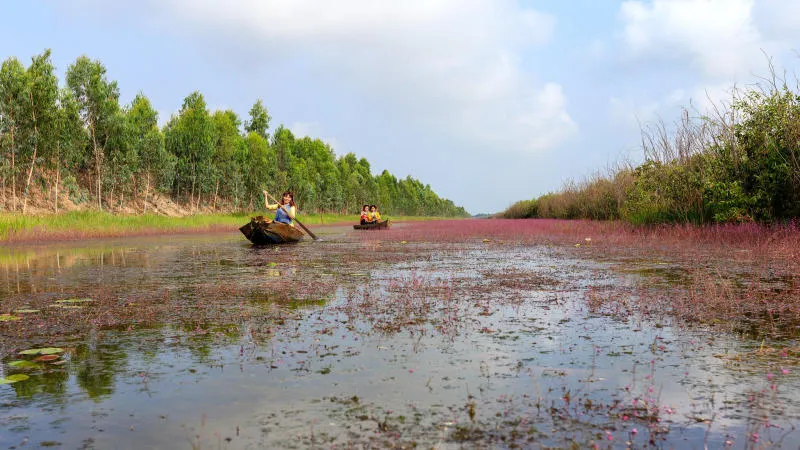
3.4 Dry Season: Opportunity to See Rare Sarus Cranes (January – June)
From January to June is the dry season in the Mekong Delta, the weather is less rainy, sunny, very suitable for outdoor tourism activities. In particular, this is also the season when Sarus cranes return to Tram Chim National Park to forage.
- See Sarus cranes: Sarus cranes are rare birds, a symbol of Tram Chim National Park. The dry season is the best time for you to have the opportunity to admire the noble and graceful beauty of this bird.
- Visit ecosystems: The dry season is also a suitable time to explore the cajuput forest, grassland, and swamp ecosystems in the national park.
- Outdoor activities: Dry weather is favorable for activities such as hiking, cycling, and boating to explore Tram Chim.
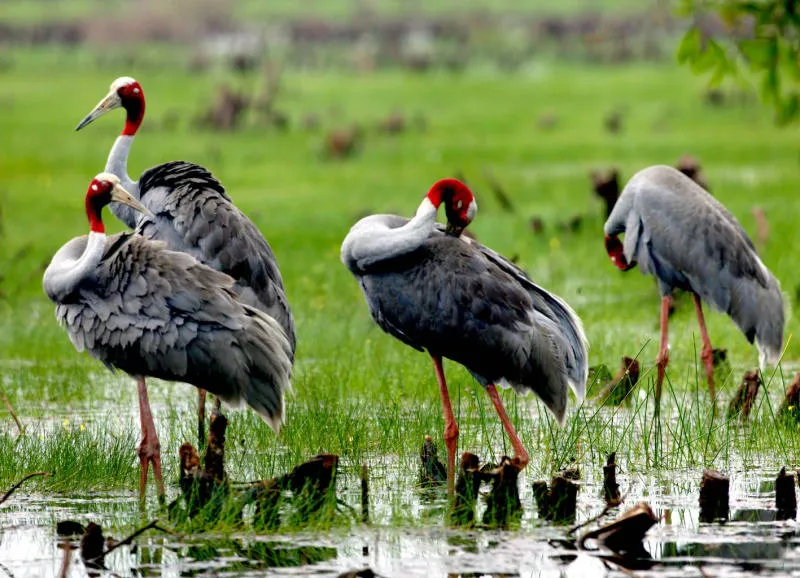
4Detailed Instructions on How to Get to Tram Chim National Park
Tram Chim National Park is about 140km from Ho Chi Minh City and about 120km from Can Tho City. Traveling here is quite convenient with many transportation options:
- Bus: Bus routes from Ho Chi Minh City and Can Tho to Dong Thap are very common. You can find reputable bus operators such as Phuong Trang, Mai Linh, Hoang Long… and choose the route to Cao Lanh or Long Xuyen, then continue to take a bus to Tam Nong or Tram Chim.
- Motorbike: For young people who like to explore and be free, a motorbike is an ideal vehicle. You can follow Google Maps directions or ask local people to get to Tram Chim. The road is quite easy and the scenery on both sides of the road is very beautiful.
- Private car: If traveling with family or a group of friends, a private car will provide comfort and proactiveness. You can easily find directions on online map applications.
Notes when traveling:
- You should carefully check the condition of your vehicle and fill up with gas before departing.
- Bring all personal papers and a driver’s license.
- Obey traffic laws and drive at the prescribed speed.
- If riding a motorbike for a long distance, you should rest regularly to ensure health.
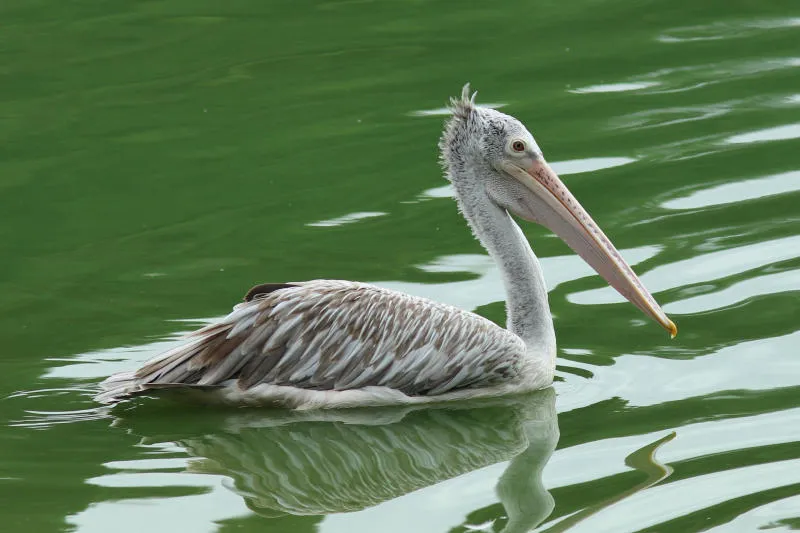
5Unique Experiences and Discovering Tram Chim National Park
Coming to Tram Chim National Park, you will have the opportunity to experience many interesting activities and explore the pristine beauty of nature:
5.1 Admire the Rare and Diverse Flora and Fauna Ecosystem
Tram Chim National Park is known as a “green paradise” with an extremely rich and diverse flora and fauna ecosystem.
- Vegetation: With more than 130 different plant species, Tram Chim is divided into many typical communities such as lotus and water lily communities, rain-fed rice communities, cajuput forest communities, and Eleocharis communities… Each community has its own beauty and is a habitat for many different animal species.
- Rare animals: The national park is home to thousands of animal species, including many rare species listed in the Vietnam and world Red Books such as Sarus cranes, Asian openbill storks, gray herons, great cormorants… In particular, the Sarus crane is a symbolic bird and the pride of Tram Chim.
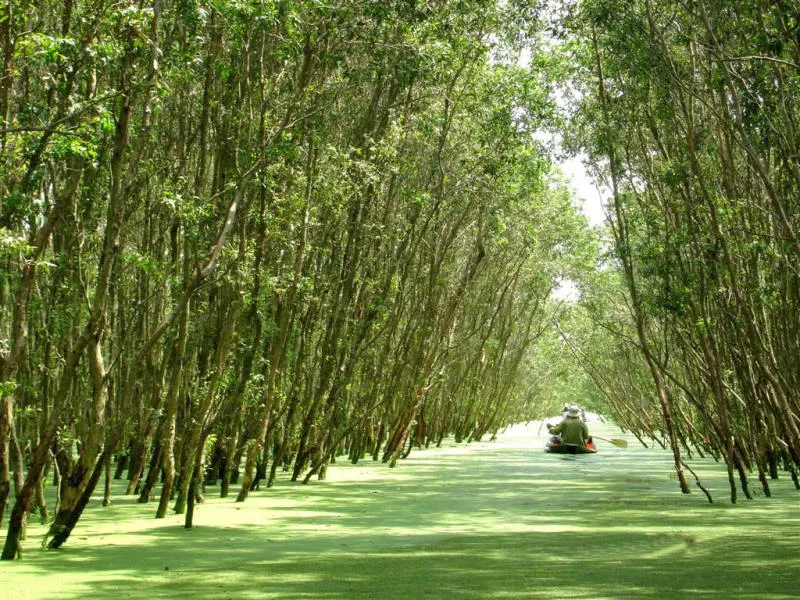
5.2 Boating Through the Cajuput Forest and Canals
One of the must-try experiences when coming to Tram Chim is boating to explore the cajuput forest and canals.
- Composite boats and wooden boats: You can rent a composite boat or a wooden boat to weave deep into the cajuput forest, admire the pristine beauty, and feel the fresh air.
- Explore canals: The intricate canal system in the national park is home to many species of fish, shrimp, and other aquatic species. You will have the opportunity to observe wildlife and admire the beautiful natural landscape.
- Watch sunrise and sunset: Boating in the early morning or late afternoon to watch the sunrise and sunset on the river is a romantic and memorable experience.
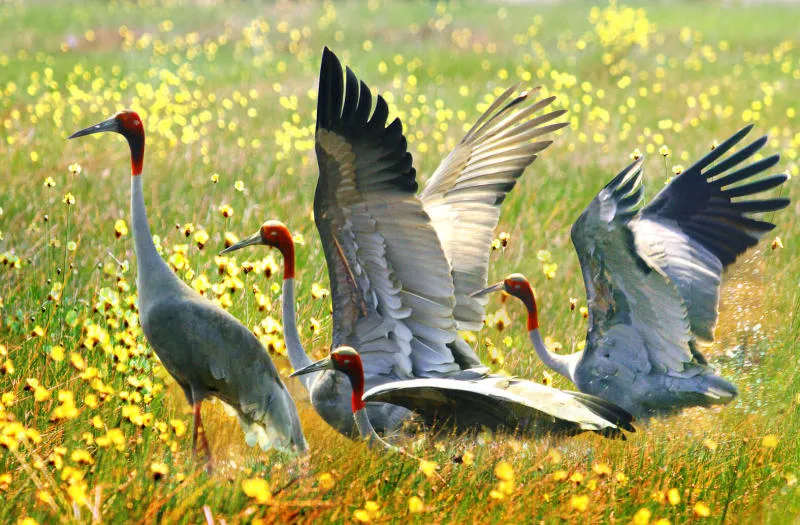
5.3 “Hunt” Photos of Sarus Cranes and Rare Birds
Tram Chim National Park is an ideal destination for nature photography enthusiasts who want to “hunt” photos of rare birds, especially Sarus cranes.
- Sarus cranes: The dry season (January – June) is the time when Sarus cranes return to Tram Chim to forage. You can rent a boat or walk to the areas where cranes often appear to admire and photograph this bird.
- Other birds: In addition to Sarus cranes, Tram Chim also has many other rare birds such as Asian openbill storks, gray herons, purple herons, and lesser whistling ducks. You can easily spot them during your visit to the national park.
- Binoculars and cameras: To “hunt” bird photos best, you should bring binoculars and cameras with telephoto lenses so you can observe and photograph from a distance without disturbing the birds.
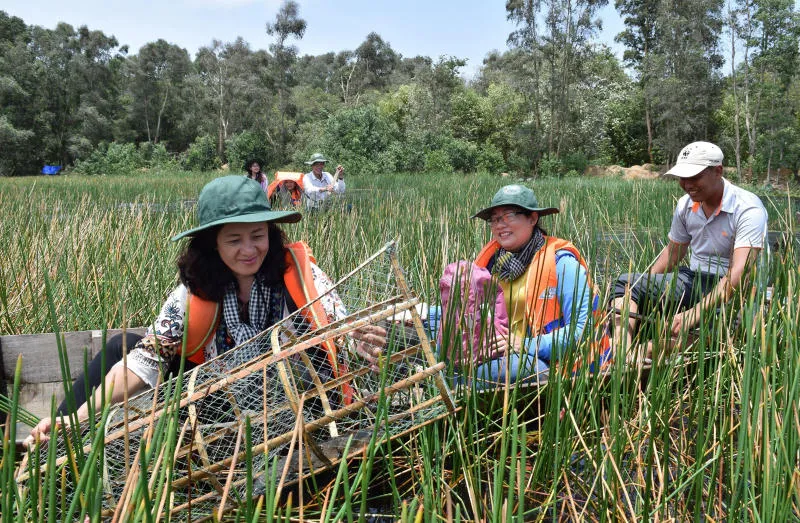
5.4 Experience a Day as a Mekong Delta Farmer
If you want to experience the authentic life of Mekong Delta people, join the “A day as a farmer” activity at Tram Chim National Park.
- Rowing a sampan: You will join farmers rowing a sampan on canals, visiting fields, and learning about their lives.
- Casting nets, setting traps, setting fish traps: You will learn how to cast nets, set traps, and set fish traps to catch fish, shrimp, and other aquatic products.
- Rice harvesting: In the rice harvest season, you will have the opportunity to go to the fields with farmers to harvest rice, experiencing the hard but also very interesting farm work.
- Enjoy rural cuisine: After a hard day’s work, you will enjoy rustic specialties prepared by yourself and local people.
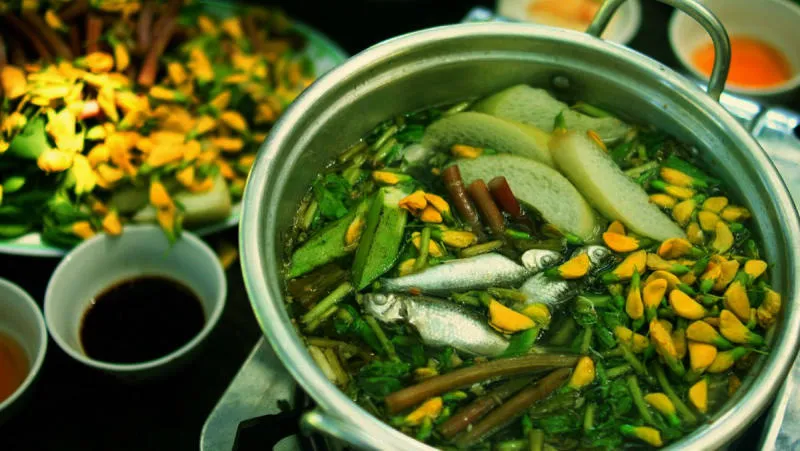
6Unique Cuisine and Souvenir Shopping at Tram Chim
6.1 Enjoy the Unique Flavors of Mekong Delta Cuisine
Coming to Tram Chim National Park, you will not only explore nature but also enjoy specialty dishes imbued with the flavors of the Mekong Delta.
- Riverside restaurants: The national park has a system of riverside restaurants, where you can enjoy cuisine while admiring the poetic natural scenery.
- Specialty dishes: Famous dishes in Tram Chim include grilled snakehead fish, field crab hotpot, Sesbania sesban flower hotpot with Siamese mud carp, grilled snails with green pepper, lotus root salad, grilled field mice…
- Fresh ingredients: Ingredients for cooking dishes are often taken from nature, ensuring freshness and bearing the typical flavors of the Mekong Delta.
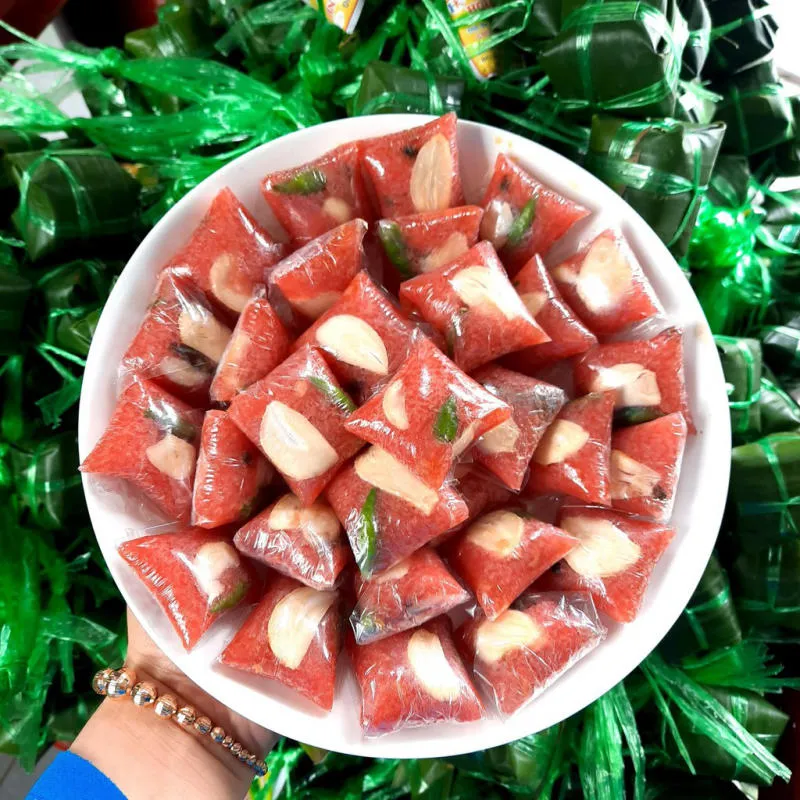
6.2 Buy Dong Thap Specialties as Gifts
After visiting Tram Chim National Park, don’t forget to buy some Dong Thap specialties as gifts for relatives and friends.
- Souvenirs: You can buy souvenirs imbued with Tram Chim imprints such as T-shirts, conical hats, and handicraft products…
- Culinary specialties: Famous specialties of Dong Thap that you can buy as gifts include:
- Fruits: Lai Vung tangerines, Cao Lanh mangoes, Chau Thanh longans, guavas, oranges…
- Lotus specialties: Lotus seeds, lotus roots, lotus stems, lotus tea, lotus jam, processed lotus products…
- Other specialties: Lai Vung fermented pork roll, dried snakehead fish, Siamese wet-cured fish, Sa Giang shrimp crackers, cajuput honey…
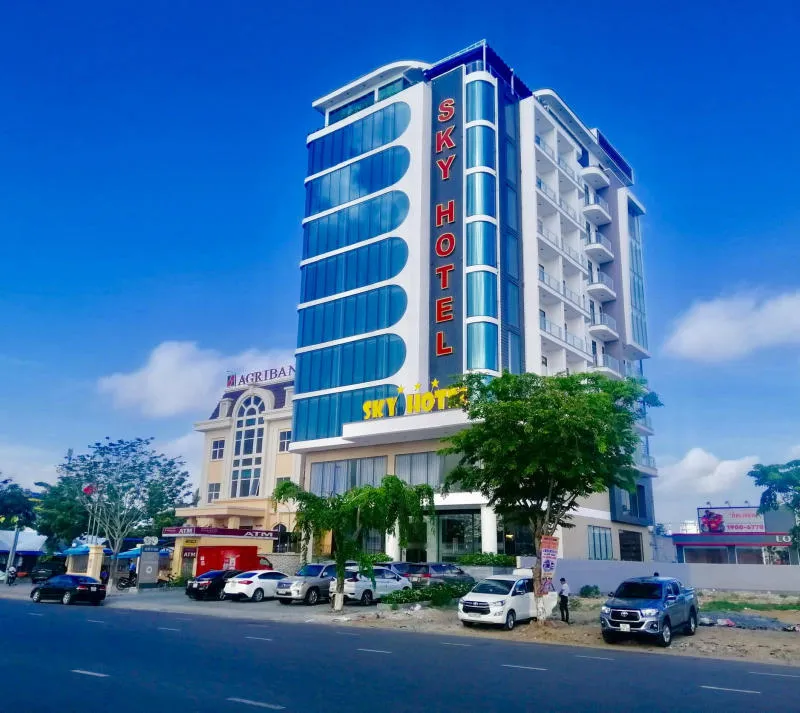
7Suggested Accommodation Options Near Tram Chim National Park
Overnight Stay Right at Tram Chim National Park
If you want to fully experience the beauty of Tram Chim, you can choose to stay overnight right in the national park.
- Hotel in the national park: The national park has a hotel with affordable prices (about 150,000 VND/person/night). However, you need to book in advance, especially during peak season.
- Sleeping at a rest stop in the forest: For those who like adventure and want to be close to nature, you can register to sleep at rest stops in the forest. This is a new and exciting experience.
Hotels and Homestays Nearby
In addition, you can also choose hotels and homestays in Tram Chim town or nearby areas such as Cao Lanh and Hong Ngu.
- Homestay – Tram Chim National Park: Homestay near the National Park, offering a cozy space and close to nature.
- Address: Tram Chim town, Tam Nong district, Dong Thap province.
- Phone: 0125 4905 128
- Sao Mai Hotel: 3-star standard hotel in Cao Lanh city, about 40km from Tram Chim.
- Address: No. 178 Nguyen Hue street, Ward 2, Cao Lanh city, Dong Thap province.
- Phone: 0277 6268 268 – 0277 3852 624 – 0919 027 752
- Sky Hotel Hong Ngu: Hotel in Hong Ngu, about 30km from Tram Chim.
- Address: Nguyen Tat Thanh street, An Thanh Ward, Hong Ngu, Dong Thap province.
- Phone: 0277 3987 666
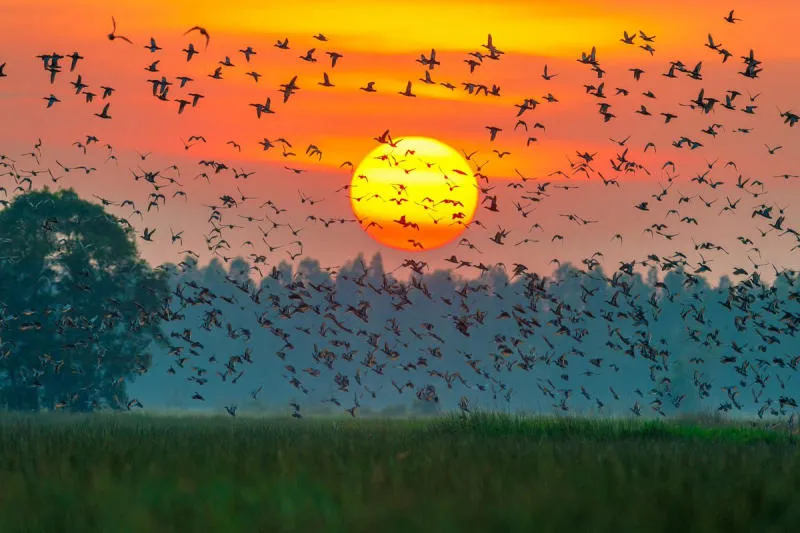
8Important Notes When Visiting Tram Chim National Park
To make your visit to Tram Chim National Park complete and safe, you need to note a few things:
- Clothing: You should choose comfortable, cool, and easy-to-move clothing. Bring a hat, sunglasses, and sunscreen to protect your skin from the sun.
- Shoes: You should wear sandals or low, waterproof shoes because the national park area has a lot of mud and water. Do not wear white shoes.
- Weather: If you go in the rainy season (July – October), you should bring a raincoat or umbrella.
- Insects: You should apply insect repellent before entering the forest to avoid mosquito and insect bites.
- Food and drinks: You should bring drinking water and snacks as a backup, especially if you participate in outdoor activities.
- Book tickets early: If you want to rent a boat for sightseeing, you should book tickets early, especially on weekends or peak season. You should arrive around 6-7 am to ensure there are still boats available.
- Cost saving: If you travel alone or in a small group, you can join a group with other guests to save boat rental costs.
- Environmental protection: Do not litter indiscriminately, do not make noise, and do not destroy plants and animals in the national park.
Note the essentials to have a complete and memorable visit to Tram Chim National Park.
9Conclusion: Tram Chim National Park – A Must-Visit Destination in Dong Thap
Tram Chim National Park is a unique and attractive ecotourism destination in Dong Thap. With a diverse and rich ecosystem, pristine and beautiful natural scenery, and exciting tourism experiences, Tram Chim will surely bring you unforgettable memories. Come to Tram Chim to discover the beauty of the “miniature Dong Thap Muoi” and immerse yourself in fresh and peaceful nature. This place is not only a tourist destination but also a place for you to find inner peace, away from the hustle and bustle of urban life.
Ta My Dung
Source: Synthesis
Keywords: Tram Chim National Park, Tram Chim tourism, Dong Thap, floating season, Sarus crane, ecotourism, Mekong Delta, Tram Chim travel experience